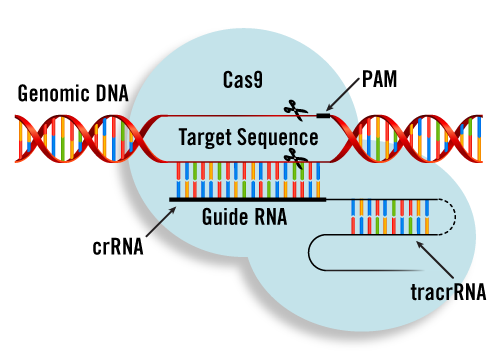CRISPR-CAS9: how does it work?
What is CRISPR-Cas9?
The CRISPR/Cas system is a system in certain bacteria that allows for acquired immunity. Once a bacterium is infected with a bacteriophage, a virus that specifically targets bacteria, the CRISPR/Cas system allows the bacterium to fight off the infection and prevent future infections from occuring.
CRISPR-Cas9, also known as CRISPR-associated protein 9, is a protein complex which is part of the adaptive immune system of the bacterium s. pyogenes. It allows scientists to make precise cuts in the DNA of any organism.
What is the CRISPR system comprised of?
In this diagram, repeats are shown as the grey boxes, and the spacers are the multicolored lines in between.
The system is comprised of four main parts: first, the CRISPR genes, which provide the instructions for the ribosomes to produce CRISPR-associated proteins, or Cas proteins.
Secondly, the leader sequence. This is a short string of DNA which is rich in A-T pairs which serves as an indicator for where new 'spacer' DNA should be placed.
Then, the repeats - short, repeating and palindromic DNA segments of around 20-40 base pairs. They are palindromic because when transcribed the RNA folds back on itself, creating a sharp hairpin turn.
Between the repeats are spacer DNA, which are snippets of viral DNA from foreign invaders that have tried to attack the cell. This viral DNA allows the Cas proteins to identify viral DNA and destroy it before it does any harm.
How does the CRISPR/Cas9 adaptive immunity system work?
Cas1, Cas2 and Cas9 are the most important Cas proteins in s. pyogenes. When a unknown virus attacks the bacterium, they destroy the viral DNA but save a section of it to add to the CRISPR array as a spacer. If the same bacteriophage attacks the bacterium, Cas9 comes into play.
First, the CRISPR array is transcribed from the leader sequence onwards, and then cleaved into smaller RNA strands by other Cas proteins into smaller CRISPR RNAs (crRNAs), consisting of a single spacer (guide RNA) and a partial repeat, or trans-activating CRISPR RNA (tracrRNA).
Cas9 then binds to the crRNA, and then the magic happens.
Cas9 searches through the genome of the host bacterium for the DNA that pairs with the guide RNA. Upon finding the target sequence - in this case, the viral DNA that has been inserted into the genome - Cas9 uses its molecular scissors - called nucleases - to cause a double strand break, also known as a DSB.
In essence, Cas9 finds a foreign sequence of DNA specified by the crRNA, and performs a precise cut to separate the DNA from the bacterium's genome.
In Part 2: How can CRISPR-Cas9 be used to introduce new genes or repair faulty ones?
Note to Readers
If there are any corrections, pieces of feedback or any suggestions for future posts you would like to put forward, please do put them down in the replies section.
If you would like to get informative tidbits of knowledge in your feed, please consider following me. It means a lot, and means that my content reaches more people. Please do resteem and upvote this post if you found it interesting!
Thanks,
Jian.


Howdy howdy

Thank you! :)
Congratulations @jiansoo! You have completed some achievement on Steemit and have been rewarded with new badge(s) :
Click on any badge to view your own Board of Honor on SteemitBoard.
For more information about SteemitBoard, click here
If you no longer want to receive notifications, reply to this comment with the word
STOP